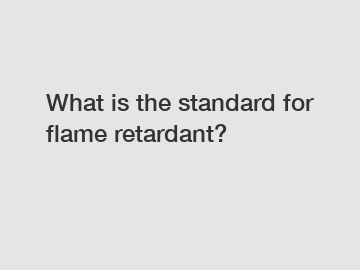Feb. 12, 2024
Textiles & Leather Products
With competitive price and timely delivery, Xinxing FR sincerely hope to be your supplier and partner.
What is the standard for flame retardant?
Flame retardants are chemicals that are added to various materials to slow down or prevent the spread of fires. They are commonly used in a wide range of products, including furniture, electronics, insulation, and textiles. However, concerns about the potential health and environmental impacts of flame retardants have raised questions about the standards and regulations regarding their use.

1. What are flame retardant standards?
Flame retardant standards are guidelines and regulations that define the performance requirements for materials in terms of their ability to resist or delay the ignition and spread of flames. These standards ensure that products meet specific safety criteria to minimize fire hazards. Different countries may have their own set of regulations and testing methods to evaluate a product's flame retardant properties.
2. Importance of flame retardant standards.
Flame retardant standards play a crucial role in ensuring the safety of consumers and reducing the risk of fire-related incidents. By establishing minimum performance requirements, these standards help manufacturers design products that are less likely to ignite or contribute to the spread of fires. Adequate flame retardancy is especially important in products that are highly flammable or commonly found in residential and commercial settings.
3. Regulatory bodies and their role.
Various regulatory bodies are responsible for setting and enforcing flame retardant standards. In the United States, the Consumer Product Safety Commission (CPSC) regulates flammability standards for various consumer products. The National Fire Protection Association (NFPA) develops and maintains fire protection codes and standards, including those related to flame retardants. Internationally, organizations like the International Electrotechnical Commission (IEC) and Underwriters Laboratories (UL) set standards for specific industries and products.
4. Common flame retardant standards.
There are several commonly recognized flame retardant standards, such as:
- California Technical Bulletin 117 (TB117): This standard addresses the flammability of upholstered furniture and requires the use of flame retardants. However, it has faced criticism due to the potential health and environmental risks associated with certain flame retardant chemicals.
- European Union REACH Regulation: REACH stands for Registration, Evaluation, Authorisation, and Restriction of Chemicals. This regulation aims to improve the protection of human health and the environment from the risks of chemicals, including those used as flame retardants.
- UL 94: This standard is widely accepted globally and assesses the flammability of plastic materials used in various electrical and electronic devices.
5. Controversies surrounding flame retardant standards.
Despite the importance of flame retardants in fire safety, there are controversies surrounding their use. Some flame retardant chemicals, such as PBDEs (polybrominated diphenyl ethers) and PBBs (polybrominated biphenyls), have been found to have negative health effects and can persist in the environment. This has led to concerns and calls for stricter regulations and alternatives to harmful flame retardants.
6. Moving towards safer alternatives.
Efforts are being made to find safer flame retardant alternatives that provide effective fire protection without the associated risks. These alternatives may include novel materials, such as inherently flame-resistant fabrics or innovative flame retardant technologies that limit chemical exposure. Research and development in this field are crucial in order to ensure consumer safety while minimizing potential harmful impacts.
7. Consumer awareness and education.
As consumers, being informed about flame retardant standards can empower us to make better choices when purchasing products. Understanding the regulations and potential risks associated with certain flame retardant chemicals allows us to select items that meet safety requirements while prioritizing our own health and the environment.
In conclusion, flame retardant standards are essential in ensuring that products we use on a daily basis are designed with fire safety in mind. However, it is equally important to address the concerns related to the potential health and environmental impacts of certain flame retardant chemicals. The development of safer alternatives, combined with consumer education and awareness, will help foster a future where fire safety is not compromised at the expense of our well-being.
If you are looking for more details, kindly visit our website.
Contact us to discuss your requirements of inherently flame resistant fabric. Our experienced sales team can help you identify the options that best suit your needs.
Previous: Which Durable Microfiber Sports Towel is Worth the Investment?
Next: Revolutionize Your Cleaning Routine with Fiber Cloth Mops: Effective & Eco-Friendly Solutions!
If you are interested in sending in a Guest Blogger Submission,welcome to write for us!
All Comments ( 0 )